The U. P. Trail Read online
Produced by Charles Franks and the Online Distributed Proofreading Team
THE U. P. TRAIL
By Zane Grey
...When I think how the railroad has been pushed through this unwateredwilderness and haunt of savage tribes; how at each stage of theconstruction roaring, impromptu cities, full of gold and lust and death,sprang up and then died away again, and are now but wayside stations inthe desert; how in these uncouth places Chinese pirates worked sideby side with border ruffians and broken men from Europe, gambling,drinking, quarreling, and murdering like wolves; and then when I go onto remember that all this epical turmoil was conducted by gentlemen infrock-coats, with a view to nothing more extraordinary than a fortuneand a subsequent visit to Paris--it seems to me as if this railwaywere the one typical achievement of the age in which we live, as if itbrought together into one plot all the ends of the world and all thedegrees of social rank, and offered to some great writer the busiest,the most extended, and the most varied subject for an enduring literarywork. If it be romance, if it be contrast, if it be heroism that werequire, what was Troy to this?
--ROBERT LOUIS STEVENSON In ACROSS THE PLAINS
1
In the early sixties a trail led from the broad Missouri, swirlingyellow and turgid between its green-groved borders, for miles andmiles out upon the grassy Nebraska plains, turning westward over theundulating prairie, with its swales and billows and long, winding linesof cottonwoods, to a slow, vast heave of rising ground--Wyoming--wherethe herds of buffalo grazed and the wolf was lord and the camp-fireof the trapper sent up its curling blue smoke from beside some lonelystream; on and on over the barren lands of eternal monotony, all so grayand wide and solemn and silent under the endless sky; on, ever on, upto the bleak, black hills and into the waterless gullies and through therocky gorges where the deer browsed and the savage lurked; then slowlyrising to the pass between the great bold peaks, and across the windyuplands into Utah, with its verdant valleys, green as emeralds, and itshaze-filled canons and wonderful wind-worn cliffs and walls, and itspale salt lakes, veiled in the shadows of stark and lofty rocks, dim,lilac-colored, austere, and isolated; ever onward across Nevada, andever westward, up from desert to mountain, up into California, where thewhite streams rushed and roared and the stately pines towered, and seenfrom craggy heights, deep down, the little blue lakes gleamed like gems;finally sloping to the great descent, where the mountain world ceasedand where, out beyond the golden land, asleep and peaceful, stretchedthe illimitable Pacific, vague and grand beneath the setting sun.
2
Deep in the Wyoming hills lay a valley watered by a stream that ran downfrom Cheyenne Pass; a band of Sioux Indians had an encampment there.Viewed from the summit of a grassy ridge, the scene was colorfuland idle and quiet, in keeping with the lonely, beautiful valley.Cottonwoods and willows showed a bright green; the course of the streamwas marked in dark where the water ran, and light where the sand hadbleached; brown and black dots scattered over the valley were in realitygrazing horses; lodge-pole tents gleamed white in the sun, and tinybits of red stood out against the white; lazy wreaths of blue smoke roseupward.
The Wyoming hills were split by many such valleys and many such bare,grassy ridges sloped up toward the mountains. Upon the side of oneridge, the highest, there stood a solitary mustang, haltered with alasso. He was a ragged, shaggy, wild beast, and there was no saddle orbridle on him, nothing but the halter. He was not grazing, although thebleached white grass grew long and thick under his hoofs. He looked upthe slope, in a direction indicated by his pointing ears, and watched awavering movement of the long grass.
It was wild up on that ridge, bare of everything except grass, and thestrange wavering had a nameless wildness in its motion. No stealthyanimal accounted for that trembling--that forward undulating quiver. Itwavered on to the summit of the ridge.
What a wide and wonderful prospect opened up to view from this loftypoint! Ridge after ridge sloped up to the Wyoming hills, and these inturn raised their bleak, dark heads toward the mountains, looming paleand gray, with caps of snow, in the distance. Out beyond the ridges,indistinct in the glare, stretched an illimitable expanse, gray anddull--that was the prairie-land. An eagle, lord of all he surveyed,sailed round and round in the sky.
Below this grassy summit yawned a valley, narrow and long, losing itselfby turns to distant east and west; and through it ran a faint, white,winding line which was the old St. Vrain and Laramie Trail.
There came a moment when the wavering in the grass ceased on the extremeedge of the slope. Then it parted to disclose the hideous visage ofa Sioux Indian in war paint. His dark, piercing, malignant glance wasfixed upon the St. Vrain and Laramie Trail. His half-naked body restedat ease; a rifle lay under his hand.
There he watched while the hours passed. The sun moved on in its courseuntil it tipped the peaks with rose. Far down the valley black and whiteobjects appeared, crawling round the bend. The Indian gave an almostimperceptible start, but there was no change in his expression. Hewatched as before.
These moving objects grew to be oxen and prairie-schooners--a smallcaravan traveling east. It wound down the trail and halted in a circleon the bank of a stream.
The Indian scout slid backward, and the parted grass, slowly closing,hid from his dark gaze the camp scene below. He wormed his way back wellout of sight; then rising, he ran over the summit of the ridge to leapupon his mustang and ride wildly down the slope.

 The Heritage of the Desert: A Novel
The Heritage of the Desert: A Novel To the Last Man
To the Last Man Desert Gold
Desert Gold The Spirit of the Border: A Romance of the Early Settlers in the Ohio Valley
The Spirit of the Border: A Romance of the Early Settlers in the Ohio Valley The U. P. Trail
The U. P. Trail The Rustlers of Pecos County
The Rustlers of Pecos County The Border Legion
The Border Legion The Young Forester
The Young Forester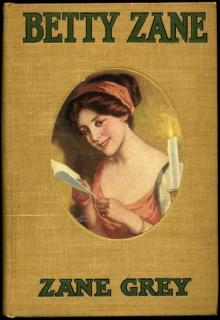 Betty Zane
Betty Zane Riders of the Purple Sage
Riders of the Purple Sage The Second Zane Grey MEGAPACK®
The Second Zane Grey MEGAPACK® The Rainbow Trail
The Rainbow Trail The Man of the Forest
The Man of the Forest The Mysterious Rider
The Mysterious Rider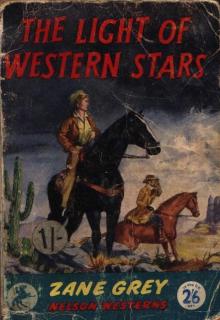 The Light of the Western Stars
The Light of the Western Stars The Last of the Plainsmen
The Last of the Plainsmen Collected Works of Zane Grey
Collected Works of Zane Grey The Call of the Canyon
The Call of the Canyon Twin Sombreros
Twin Sombreros The Dude Ranger
The Dude Ranger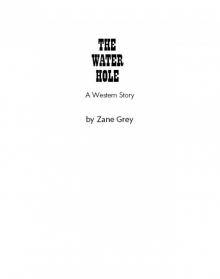 The Water Hole
The Water Hole Raiders of Spanish Peaks
Raiders of Spanish Peaks West of the Pecos
West of the Pecos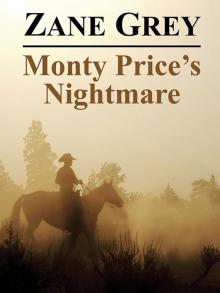 Monty Price's Nightmare
Monty Price's Nightmare Stairs of Sand
Stairs of Sand Rogue River Feud
Rogue River Feud Union Pacific
Union Pacific The Western Romance MEGAPACK ®: 20 Classic Tales
The Western Romance MEGAPACK ®: 20 Classic Tales The Lone Star Ranger
The Lone Star Ranger The Zane Grey Megapack
The Zane Grey Megapack Shadow on the Trail
Shadow on the Trail The Vanishing American
The Vanishing American The Trail Driver
The Trail Driver War Comes to the Big Bend
War Comes to the Big Bend The Westerners
The Westerners Silvermane
Silvermane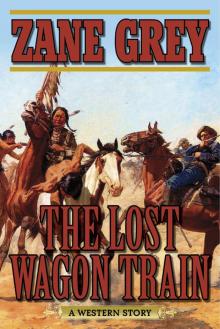 The Lost Wagon Train
The Lost Wagon Train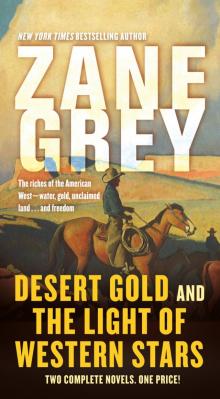 Desert Gold and the Light of Western Stars
Desert Gold and the Light of Western Stars Wildfire and the Heritage of the Desert
Wildfire and the Heritage of the Desert The Great Trek
The Great Trek Cabin Gulch
Cabin Gulch Code of the West
Code of the West Sunset Pass
Sunset Pass Panguitch
Panguitch The Drift Fence
The Drift Fence Dorn Of The Mountains
Dorn Of The Mountains Desert Heritage
Desert Heritage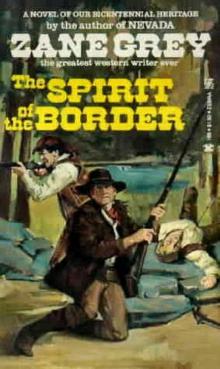 The Spirit Of The Border
The Spirit Of The Border Buffalo Stampede
Buffalo Stampede The Hash Knife Outfit
The Hash Knife Outfit The Lone Star Ranger and the Mysterious Rider
The Lone Star Ranger and the Mysterious Rider The Shepherd of Guadaloupe
The Shepherd of Guadaloupe Riders of the Purple Sage (Leisure Historical Fiction)
Riders of the Purple Sage (Leisure Historical Fiction) Thunder Mountain
Thunder Mountain The Spirit of the Border and the Last Trail
The Spirit of the Border and the Last Trail The Day of the Beast
The Day of the Beast The Heritage of the Desert
The Heritage of the Desert The Deer Stalker
The Deer Stalker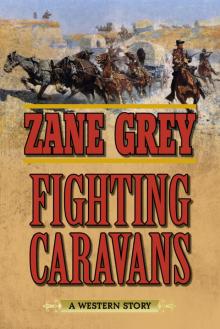 Fighting Caravans
Fighting Caravans